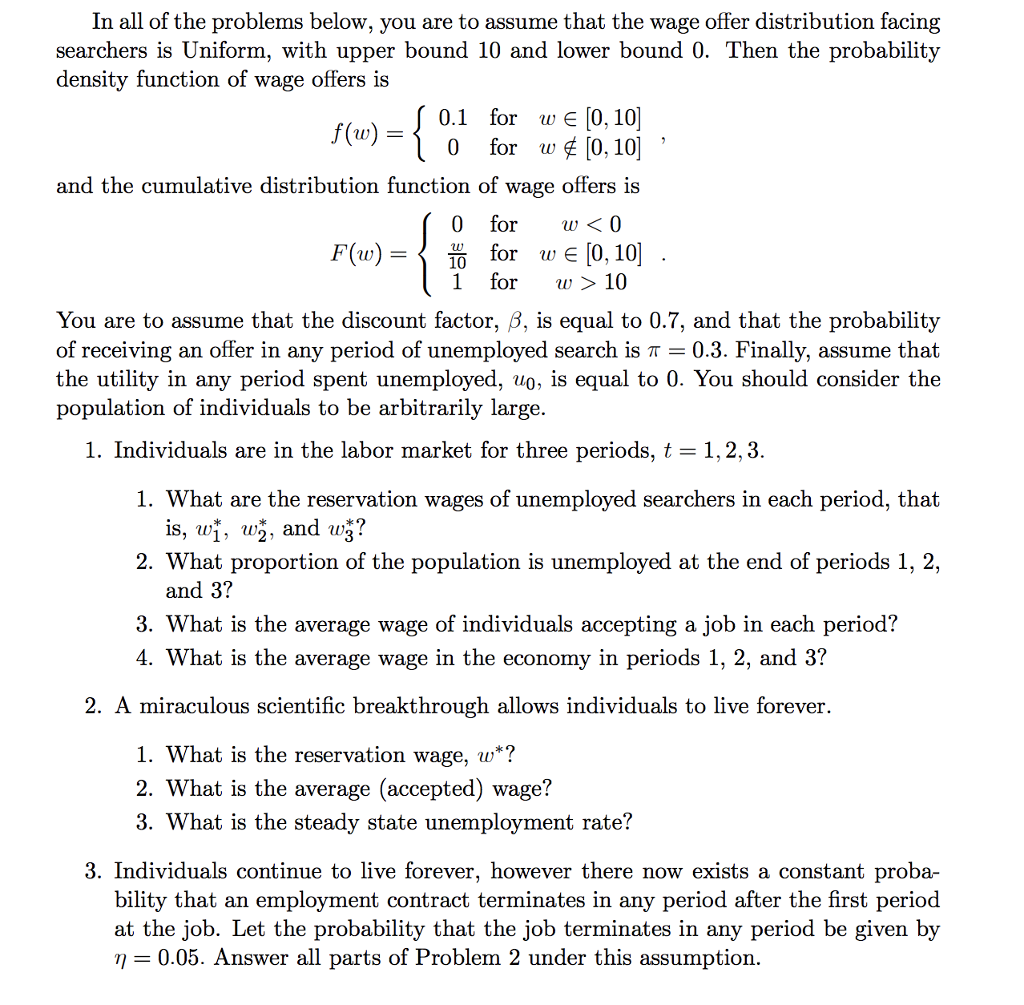
In all of the problems below, you are to assume that the wage offer distribution facing searchers is Uniform, with upper bound 10 and lower bound 0. Then the probability density function of wage offers is S 0.1 for w e [0, 10] f(w) = 0 for w [0, 10) and the cumulative distribution function of wage offers is ( 0 for w 10 You are to assume that the discount factor, B, is equal to 0.7, and that the probability of receiving an offer in any period of unemployed search is T = 0.3. Finally, assume that the utility in any period spent unemployed, uo, is equal to 0. You should consider the population of individuals to be arbitrarily large. 1. Individuals are in the labor market for three periods, t = 1, 2, 3. 1. What are the reservation wages of unemployed searchers in each period, that is, wi, w, and wz? 2. What proportion of the population is unemployed at the end of periods 1, 2, and 3? 3. What is the average wage of individuals accepting a job in each period? 4. What is the average wage in the economy in periods 1, 2, and 3? 2. A miraculous scientific breakthrough allows individuals to live forever. 1. What is the reservation wage, w*? 2. What is the average (accepted) wage? 3. What is the steady state unemployment rate? 3. Individuals continue to live forever, however there now exists a constant proba- bility that an employment contract terminates in any period after the first period at the job. Let the probability that the job terminates in any period be given by n= 0.05. Answer all parts of Problem 2 under this assumption. In all of the problems below, you are to assume that the wage offer distribution facing searchers is Uniform, with upper bound 10 and lower bound 0. Then the probability density function of wage offers is S 0.1 for w e [0, 10] f(w) = 0 for w [0, 10) and the cumulative distribution function of wage offers is ( 0 for w 10 You are to assume that the discount factor, B, is equal to 0.7, and that the probability of receiving an offer in any period of unemployed search is T = 0.3. Finally, assume that the utility in any period spent unemployed, uo, is equal to 0. You should consider the population of individuals to be arbitrarily large. 1. Individuals are in the labor market for three periods, t = 1, 2, 3. 1. What are the reservation wages of unemployed searchers in each period, that is, wi, w, and wz? 2. What proportion of the population is unemployed at the end of periods 1, 2, and 3? 3. What is the average wage of individuals accepting a job in each period? 4. What is the average wage in the economy in periods 1, 2, and 3? 2. A miraculous scientific breakthrough allows individuals to live forever. 1. What is the reservation wage, w*? 2. What is the average (accepted) wage? 3. What is the steady state unemployment rate? 3. Individuals continue to live forever, however there now exists a constant proba- bility that an employment contract terminates in any period after the first period at the job. Let the probability that the job terminates in any period be given by n= 0.05. Answer all parts of Problem 2 under this assumption







